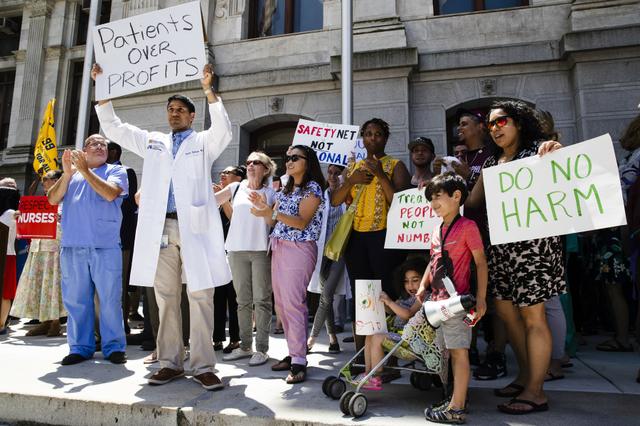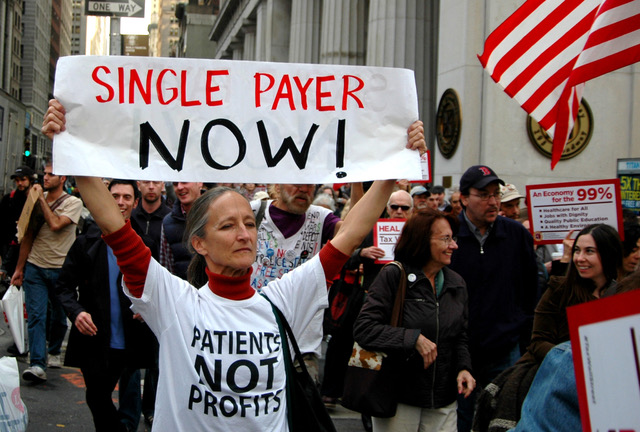
|
Jennifer G had been under the care of the same doctor for many years. When she woke up one morning with an extremely swollen left hand, she immediately called his office expecting the doctor to see her immediately as he had on many other occasions. It was quite a shock to be told that the doctor would not be able to see her for two weeks. She was instead offered the services of an APRN who could see her that day. |
What Jennifer did not know (and probably never will) is that her doctor’s practice had been sold to a private equity firm hunting for bountiful returns quickly. Patients like Jennifer are shunted to lower-paid employees leaving doctors free to treat patients with “higher value” potential. There are other consequences when profit-making companies invade healthcare — lapses of quality care, market-driven consolidations that often drive out competition and increased use of meaningless diagnostic tests to enhance profitability.
It’s official: the trillion-dollar healthcare industry is the target of profit-driven, corporate bloodsuckers. No less an authority than PwC, a global accounting firm, points a finger at private equity as “healthcare’s new growth accelerator.” And the Centers for Medicare and Medicaid Services (CMS) predict that healthcare will rise from 18% of the national economy (GDP) to 20% by 2026, making it an even juicier target. Factor in an aging population whose medical needs, real or imagined, lead to increased utilization of the medical system, the prevalence of chronic conditions ((diabetes, high blood pressure) a result of poor diet and life-style choices and over-utilization of drugs and advanced (expensive) diagnostic tests. And last but hardly least— a recession-proof industry.
Private equity has gotten the message. The next time you wind up in an emergency room anywhere in the U.S., be aware that in 65% of U.S emergency rooms your caregivers are contractors working for outside profit-making corporations. Hospitals, also marching to the drumbeat of profitability, are in the process of selling off the remaining emergency rooms to leave them unencumbered by low-profit healthcare to invest in high-profit financial markets.
In 2017, the largest non-profit hospitals took in a collective $21 billion on their investments in the private sector, with a profit margin of 6.7%, triple the measly 2.7% profit on what is supposed to be their core business: patient care. (Axios financial records analysis)

Private equity’s influence can be found all over healthcare. The next time you visit your PCP, be prepared to encounter a fast-paced environment where profits come first, patient care second. Your time with the doctor will be limited to 11-15 minutes. After all time is money. In most cases, as we saw with Jennifer, you will be steered to a lower paid professional keeping the doctor free to cater to patients whose condition or gullibility raise their income potential. From the point of view of profit-driven hustlers, chiselers and bottom feeders in the shadow banking world, investing in healthcare is a can’t lose proposition.
As the healthcare gravy train rolls out of the station, private equity occupies most of the seats. In 2019, private equity’s worldwide healthcare acquisitions exceeded $63 billion. In its self-appointed role as the world’s exceptional nation, the U.S. led the pack in healthcare acquisitions with 84 deals worth $23 billion. Where is all that money going? In a surprising turnaround, private equity, which has traditionally shied away from Big Pharma in its hunt for quick returns has become a major investor. In another shift, the free-wheeling private equity honchos who are presently sitting on $2.5 trillion in unspent cash have diversified and shifted investment money away from the acute care sector (emergency rooms and surgical settings) to more consumer-friendly sectors (urgent care drop-in centers, home health care, dental, chronic care, dermatology, substance abuse centers and physical therapy), where the profit possibilities are mind-blowing.

Forget about a national health care system, what exists is an increasingly privatized free-market where shady operators are investing mountains of cash to bring in expected returns of twenty-five percent or more. In this twenty-first century gold rush, the investors are the winners, patients the losers.
The unfortunate consequence of this health care business model is to downgrade the quality of care for patients. Facing long waits to see their doctor a deliberate strategy to encourage utilization of lower-paid employees, stuck in a system where cost containment has left the building, coerced into expensive and mostly meaningless diagnostic tests and subject to surprise bills they are personally responsible for even if they are insured (more about surprise billing in a later article), patients are odd man (and woman) out.
As the national health care debate was heating up, along came Barack Obama whose entire presidential campaign was built on false promises (aka lies), including the fate of national healthcare. In 2009, he gave a speech to Congress stressing the need for a total revamp of the U.S. healthcare system. Many Americans believed they had finally elected a President committed to fulfilling his campaign promises. He spoke about “[the] more than thirty million American citizens who cannot get coverage.” Oops, guess how many “American citizens” five years after Obamacare went into effect still lack health insurance: thirty million. He also decried the high cost and diminished effectiveness of healthcare U.S.A-style — “We spend one-and-a-half times more per person on health care than any other country, but we aren’t any healthier for it.”
The good news is that the U.S. no longer spends one and one-half times more on healthcare. The bad news — U.S. health care costs are now double those in comparable countries. When it comes to health outcomes, another bitter disappointment awaits. Life expectancy in the U.S. has plummeted for two out of the past three years (CDC). As far as the lefty dream of a national insurance plan, Obama demolished that idea using the same rationale as the one he used for not punishing the George W, Bush crew as war criminals (I don’t believe anyone is above the law. One the other hand, I also have a belief that we need to look forward as opposed to looking backward…) Obama’s healthcare dodge was similar — “I believe it makes more sense to build on what works and fix what doesn’t, rather than try to build an entirely new system from scratch.” There’s lots more to wail about but why look backward when the future looks ever so much grimmer.
The moral of eight years of Obama’s dutiful subservience to the neocons —if wishes were horses, beggars could ride. The same goes for the current condition of the majority of Americans. Wishing will not make U.S. leaders “come to their senses.” Public pressure might.

The financial world is stealthily wrapping its greedy balance sheets around the $3.65 trillion the U.S. is currently spending to make patients sicker. If politics is the people’s way of making collective decisions (Douglas Valentine), 2020 is the perfect time to put that theory to the test by choosing a leader who will create a healthcare system that dispenses wellness and alleviation of suffering, rather than big-time shareholder returns.
As John Lennon once said: “Imagine.”
(Click here to read another in SA’s exposés of the financialization of U.S. healthcare in “Putting Patients Last: The Corporate Capture of Doctors.”
601 total views, 1 views today
